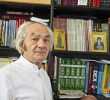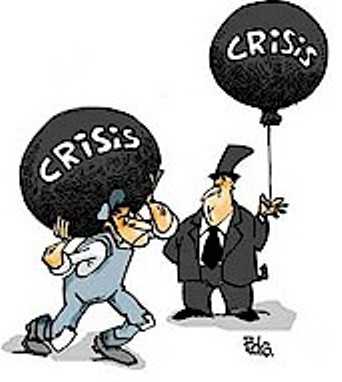Stare de urgenta (Noutati 1 octombrie 2008)

- Antena3: Bush despre criza financiară: Situaţia e dificilă. Milioane de americani vor avea de suferit
- Blogul lui Catalin Tolontan: Bush, discurs ultimativ ca-n “Ziua Independentei”
“George Bush a tinut acum o ora un discurs in care a descris situatia economica a Americii prin termenul “stare de urgenta”. Daca s-ar fi referit la un cutremur, toata lumea ar fi alertata. Fiind vorba de economie, termenii trec mai usor nebagati in seama.Cele aproape 4 minute ale presedintelui sint intesate de termeni precum “criza” si “durere”. El se adreseaza “cetatenilor Americii, dar si celor ai intregii lumi”, cerind alesilor SUA sa voteze planul de urgenta de 700 de miliarde de dolari, respins ieri. Undeva in discurs spune ca nu sintem in situatia de a delibera daca e bine sa intervina guvernul sau sa lasam piata sa actioneze pentru ca timpul unor astfel de decizii a trecut si acum fie intervine guvernul, fie milioane de americani vor avea de suferit.
Mesajul e universal si, vazindu-l prins intre nevoia de a transmite incredere si teama evidenta care i se citeste pe chip, nu te poti opri sa nu-l compari cu presedintele din “Ziua Independentei”, vorbind Americii si lumii in incercarea disperata de a salva situatia. Cu doza de regie hollywoodiana, evident  Informatiile si evaluarile de care dispune, care sint altele decit ale unui om obisnuit, ii transmit, probabil, ca in aceste zile se joaca mai mult decit poate spune chiar si paloarea de pe fata lui“.
Informatiile si evaluarile de care dispune, care sint altele decit ale unui om obisnuit, ii transmit, probabil, ca in aceste zile se joaca mai mult decit poate spune chiar si paloarea de pe fata lui“.
- Adevarul: Criza din SUA, la un nou apogeu
- Ziua:
Analisti: Statele Unite nu mai pot scapa de recesiune
Criza in casa spanzuratului de Eduard IVASCU
- EvZ: Guvernul recunoaşte pericolele crizei
- Gandul: – Românii îşi potrivesc ceasul după ora Americii
- Bogdan Stanciu: A venit scadenta, baieti!
- Atitudini fara platitudini:
Ron Paul despre criza economica din SUA
Feminista Camille Paglia admite ca avortul e o crima, dar…
Scrisoare deschisa catre Sarah Palin si falimentul multiculturalismului
- Blog ANTI-UE:
UE joaca, in mod ipocrit, cartea antiamericanismului
Pe ce mai arunca banii UE!
- Miscarea de Rezistenta: Cipurile RFID invadeaza Anglia si Sua
- Parintele Savatie: Teoria subconştientului, un plagiat tîrziu
- Claudiu Tarziu: ROST, despre Părintele Chesarie Gheorghescu


















 Doneaza pentru filmul "Scrum"
Doneaza pentru filmul "Scrum"





































































Criza financiara din SUA , etapa principala in edificarea NOII ORDINI MONDIALE
David Rockefeller :
„Tot ce avem nevoie este o criza majora, iar natiunile vor accepta Noua Ordine Mondiala „
Am facut aceasta introducere deoarece evenimentele recente din domeniul financiar – bancar impun reconsiderarea a ceea ce pana acum era simplist etichetat ca teoria conspiratiei si reprezinta a doua etapa majora ( dupa masurile luate in urma evenimentelor din 11.09.2001 ) din ultimul capitol al edificarii societatii de tip Big Brother planetar .
Retineti va rog entitatile si personajele cheie din aceste evenimente :
JPMorgan Chase
Citigroup Inc
Federal Reserve
Henry Paulson
Ben Bernanke
In cursul urmatorului scurt istoric ne vom reintalni cu ele si vom constata impreuna cum se leaga lucrurile .
Inca de anul trecut semnalam cu obstinatie ca urmeaza o MEGA CRIZA formata dintr-un cumul de crize ( pe care mass-media corporatista le prezinta ca fara a avea legatura intre ele ) : financiar bancara , petroliera , alimentara , miscari de strada , razboi mondial , implanturi cu microcipuri .
Iata ca anul acesta primele doua au „ explodat „ , urmeaza a treia si in 1-2 ani restul . De ce ? Pentru instaurarea Big Brother totalitar , super formatiunea statala multinationala politieneasca formata din strict doua clase sociale : ELITELE si plebea de consumatori unelte , albine intr-un urias stup . Pe parcursul acestui articol voi incerca sa demonstrez acest lucru .
http://saccsiv.weblog.ro/2008-09-27/534502/Criza-financiara-din-SUA-%2C-etapa-principa—.html
Ultima mare criza financiara de pe Wall Street, in 1929, a cazut la tanc. Pe de o parte, sistemul “capitalist” trecea printr-o grava si cumplita criza, in timp ce in Rusia se construia societatea viitorului, cea a comunismului. Deci, avantaj pentru ideologia comunista si pentru sistemul sovietic.
O alta consecinta, si mai importanta, a fost NEW DEAL. Administratia americana, culmea, republicana (adica, formal, conservatorii), condusa de Roosevelt, a adus si pe acele vremuri “solutia”. NEW DEAL era un program de salvare a natiunii si economiei americane, bazat pe teoriile lui Keynes. Dar Keynes a fost teoreticianul cel mai important al economiei de tip social-democrat (sau, mai franc spus, socialist) si al statului de tip welfare, adica mega-statul care controleaza, prin sistemul de asigurari sociale, toata viata individului de la nastere pana la moarte.
Ei bine, in SUA era cam greu de aplicat asemenea idei straine de spiritul liberal economic, specific americanilor. Doar o astfel de criza a facut posibila aplicarea unui program statal de interventie ca NEW DEAL, prezentat in manualele comuniste drept un mare succes.
NEW DEAL a insemnat, deci, o interventie fara precedent a statului in economie, deci un CONTROL fara precedent instaurat. Niciodata economia americana nu a mai aratat ca inainte. Sistemul statalo-financiaro-industrial, sau “complexul”, cum este numit de economistii libertarieni, a pus stapanire pe SUA si si-a consolidat dominatia.
Ce vedem ca se petrece acum? Marile banci europene, pentru a fi “salvate”, sunt nationalizate. Fortis, Dexia, Hyppo, si alte mari banci europene, au fost deja nationalizate. Statul, inclusiv cel american, arunca cu bani ca sa “salveze” si alte banci. Evident, statul le salveaza, insa prin asta, de fapt, le trece sub CONTROLUL sau.
Cu cat mai mare criza, cu atat mai mare CONTROLUL. Sub pretextul “salvarii”….
Fara a lua apararea vre unui sistem politic de orice natura ar fi si oriunde ar opera el in lume, cred ca pozitia pe care trebuie sa o avem noi, in calitate de crestini ortodocsi, este cu totul alta.
Oare poate cineva, (fie el si “expert economic”) sa afirme cu certitudine si sa exemplifice care system economic sau politic din istoria omenirii si-a indeplinit misiunea promisa? Majoritatea din noi cautam astazi solutii la multe crize (ca sunt economice sau nu) insa le cautam in “all the wrong places”.
Cu 2000 de ani in urma, in vremea Domnului Iisus, situatia nu era nici pe departe mai buna: – ocupatia Romana, sistemul de taxe al vremii, sistemul Herodian, cresterea immigrarii strainilor si influenta lor asupra “poporului ales”. Criticii iudei ai vremii nu incetau sa scoata in evidenta “neputinta” Domnului de a adresa so corecta aceste probleme.
Traim probabil cele mai cinici vremuri din istoria Americii si poate a omenirii. Si cu toate acestea, in mijlocul crizei si colapsului, cuvintele Mantuitorului nu sunt mai putin adevarate:
“Un singur lucru trebuie!”; “Cautati mai intai Imparatia lui Dumnezeu…’, Nu va ingrijiti de ziua de maine…ajunge zilei rautatea ei” (Matei)
Aceasta atitudine nu reprezinta slabiciune sau fatalism, ba dimpotriva, opusul.
Problemele cu care se confrunta lumea de astazi nu sunt nici economice si nici politice ci duhovnicesti. Lumea post-moderna a suferit o pierdere “fundamentala” nu in economic ci in virtute. Fara principii care sa isi aiba radacinile in Adevarul Divin, ca sursa a intregii vieti, libertati, moralitati si justitii, lumea graviteaza in haos, fara ratiuni clare, nici macar “raison d’etre”. Fara acest fundament de virtute, politicieni, jurnalisti si chiar cetateanul de rand, inceteaza sa mai fie preocupat de Adevar si Dreptate ci numai de putere, influenta si privilegii.
Ca cetatean al acestei tari cred ca sursa crizei curente din SUA nu consta in lipsa de legi sau in felul de aplicare a lor, ci in lipsa de caracter. Insa poate spune cineva ca Europa “crestina” sta mai bine la acest capitol?
Pentru noi crestinii, Domnul Hristos nu a venit sa ne invete cum sa reformam guverne si institutii financiare ci cum sa ne reformam sufletele, cum sa le aducem la starea dintai. Sufletele dreptilor sunt “sarea pamantului” sunt “lumina lumii”, ele sunt cele care dau sens societatii si o poarta inainte.
Hristos cu noi!
Desigur ca ar trebui cu totii sa fim “nu din aceasta lume”. Legi crestine nu mai exista de mult, iar in viitor legile vor fi din ce in ce mai anti-crestine! Cind imparatul Crestin Ortodox (sau regele, sau printul, etc.) domnea peste un anume tinut, se straduia, daca avea aceasta straduinta, sa puna legi pentru a ajuta formarea unor suflete gata de viata viitoare. Deci, traind intr-o lume cazuta, nu mai avem nevoie si de legi de aceeasi natura cazuta, pentru ca ele vor fi piedici. Aceste piedici le intalnim acum la tot pasul, pentru a fi mereu raniti, deznadajduiti, suparati si mereu nervosi. Nu mai este sprijin nici in vladici, decit foarte putin…
Mila Domnului!
@ Economistul – mici precizari:
1. Rosevelt, singurul presedinte american care a castigat 4 mandate, era democrat, nu republican!!!
2. J.M. Keynes era un homosexual notoriu, ceea ce nu inseamna ca as exclude posibilitatea ca cineva sa se pocaiasca chiar si de un astfel de pacat, insa ceea ce vreau sa spun este ca ‘pomul bun se cunoaste dupa roadele sale’. un pom rau nu poate da roade bune… NICIODATA!
societatea umanista in care traim, de la Iluminism incoace, de aproape 250 de ani, este construita pe ideile a tot felul de ‘genii’ (ganditori, scriitori, politicieni, oameni de stiinta) care sunt, din nefericire, tot astfel de ‘pomi rai’. inainte de a crede idele cuiva, eu zic ca – fara a judeca si a exclude posibilitatea de mantuire a aceluia! – sa ne uitam la calitatea morala a vietii sale. de sute de ani incoace, ‘operele’ a tot felul de curvari, betivi, ucigasi, atei, inversionisti, ne sunt bagate in manuale si pe gat drept ‘mare cultura’…
din nefericire, cu sau fara criza, ‘ei’ (acesti antemergatori ai Antihristului) au controlul asupra a tot ceea ce tine de lumea asta. noi sa avem grija sa nu lasam in mainile lor sufletele noastre, pe care doar de bunavoie le putem ceda… altfel nu au nicio putere…
…insa stim prea bine ca nu ‘cultura’ mantuieste si ca nu exista, in Ortodoxie, niciun sfant care sa dainuiasca prin vorbe dupa mintea sa, ci pt ce a grait Duhul Sfant in acela. si Duhul Sfant nu salasuieste in oameni plini de pacate. in oameni pocaiti chiar de pacate abominabile – da! insa in oameni nepocaiti, chiar si de ceea ce ei numesc ‘pacate mici’ (o tigara, o barfulita, o ocheada pofticioasa), Duhul Sfant nu va salasui niciodata!
Vaccinul anti-HPV Gardasil – Silgrad: Pericol de moarte!
Cum Nicolaescu a anuntat de curand ca din toamna incepe vaccinarea cu Silgrad, am continuat sa caut materiale. Am pus la Anexe mai multe studii interesante, din pacate doar in limba engleza.
A aparut si in Ziua ceva pe aceeasi tema.
Totodata pot afirma ca mi-am format in sfarsit o opinie: voi refuza vaccinarea fetelor mele cu Silgrad, intrucat:
– s-au inregistrat alarmant de multe cazuri de posibile efecte adverse, inclusiv decese; chiar daca nu s-a stabilit cu certitudine ca acestea din urma sunt legate direct de administrarea vaccinului (dar nici contrariul!) riscul este prea mare;
– vaccinul nu a fost testat suficient de mult timp ca sa se vada urmarile lui, intrucat a aparut abia la finalul anilor ‘90; deci, pe termen lung, nu putem sti care vor fi efectele sale;
– vaccinul imunizeaza doar impotriva a cateva tipuri de HPV (Human Papilloma Virus 6, 11, 16, 18);
– alte studii arata ca incidenta cancerului de col uterin este legata direct si de avort. Cum Romania este “campioana europeana” la aceasta indeletnicire criminala, nu-i de mirare ca suntem primii in Europa la cancerul de col uterin. Solutia? Educarea crestina, in responsabilitate si dragoste, a copiilor, sa nu isi inceapa viata sexuala nesabuit si sa nu avorteze. Si sa nu uitam de impartasirea cat mai deasa a copiilor nostri, caci ii apara de rele.
Iata mai jos insemnarile mele originale:
Multumesc d-lui dr. Pavel Chirila [www.naturalia.ro] pentru modul in care mi-a deschis ochii asupra efectelor secundare pe care le pot avea nenumaratele vaccinuri incluse in programul national de vaccinare pentru copii. De atunci subiectul ma intereseaza si, cu cat caut mai adanc, cu atat inteleg ca, de fapt, nu sanatatea viitoarelor generatii este scopul acestor campanii.
Ultimul exemplu, poate mai alarmant decat toate celelalte, este Gardasil, vaccinul anti-HPV (human papiloma virus, cel care provoaca 70% din cazurile de cancer de col uterin), , care ar putea fi introdus in Romania in programul de vaccinare obligatorie incepand din aceasta toamna!
Ce motiv ar fi avut fostul secretar de Stat al SUA Madeleine Albright sa propuna Romaniei astfel de “ajutor”? Poate este preocupata, mai nou, de sanatatea si bunastarea copiilor lumii, dupa ce acum cativa ani declara ca moartea a jumatate de milion de copii irakieni este un pret acceptabil pentru democratizarea tarii? Si chiar daca aceasta expresie (a carei veridicitate nu este, pana la urma, confirmata din surse presupus obiective) ar fi un fals, Albright ar fi primul inalt demnitar al unui guvern american care isi dedica din timp salvarii unor vieti dupa ce, pe timpul investiturii sale, a dovedit – spre exemplu in timpul invadarii Serbiei in 1999 – ca nu da, de fapt, doua parale pe viata umana, atunci cand este vorba de interese de grup financiar sau politic.
Vaccinul, fabricat de concernul Merck Sharp & Dohme, nu este testat pe termen lung, ceea ce este o problema in sine; in plus, internetul vuieste de povesti despre efectele secundare imediate ale vaccinului, inclusiv moartea, in procesul de testare si aprobare. Se pare ca, in unele state din SUA, incercarea de a impune vaccinarea obligatorie cu Gardasil a esuat in fata opozitiei parintilor. Asa ca Merck si-a mutat atentia spre Romania, unde oamenii sunt mamaligosi si suporta orice, inclusiv un vaccin netestat care este posibil sa le ucida sau schilodeasca copiii.
Despre efectele secundare in Ziarul, dar si mai jos, intr-un articol recent de pe un site prolife american.
In SUA, Centre for Disease Control a promis pentru luna octombrie un raport referitor la acest vaccin. – Voi urmari si voi reveni cu concluziile acestuia.
Ramane de urmarit cum vor proceda autoritatile medicale romanesti, care va fi raspunsul ’societatii civile’ (daca va fi vreunul!) si daca se va impune obligativitatea acestei vaccinari pentru fetitele romance.
Si ca sa nu se spuna ca pic in “conspirationism” (desi eu sunt convins ca Albright, ca o adevarata trilateralista si membra a Grupului Bilderberg, e interesata si de politicile de control al populatiei – unul din efectele secundare ale Gardasil este sterilitatea!) sa luam doar latura financiara a “grijii parintesti” manifestate de Albright. Ziarul scrie:
..o astfel de deplasare nu este chiar un act de “binefacere”, ci se intreprinde pe bani foarte multi[…] Compania de medicamente Merck & Co se asteapta la vanzari de cel putin 4 miliarde de dolari anual doar in SUA, militand pentru ca vaccinul HPV sa fie administrat in scoli obligatoriu. Costul dozelor vaccinului “obligatoriu” leviteaza in jurul a 300 de euro pentru o persoana. In Romania traiesc circa 125.000 de tinere eleve care ar urma sa fie vaccinate “obligatoriu”. Daca inmultim aceste cifre cu 300, rezultatul devine foarte interesant financiar. (37,5 milioane de Euro)
Cat o fi comisionul madamei in afacerea asta?!
Vezi si http://nuvaccinurilor.blogspot.com/.
Acum urmeaza anexele:
=========================================================================
1. Raportul grupului Judicial Watch cu privire la efectele negative ale administrarii Gardasil-ului [pdf pentru descarcat]
Rezumat: pacientele reclama de la dureri de cap, ameteli, stari de voma, aparitia unor negi pe fata sau corp, infectii ale cailor respiratorii, dureri de dinti, pierderea cunostintei, paralizii. S-au inregistrat de asemenea cateva zeci de decese, insa Judicial Watch apreciaza ca, si in cazul in care “ar fi vorba de simple coincidente, dat fiind faptul ca exista inca multe necunoscute privind siguranta completa a Gardasil acestea nu pot fi pur si simplu ignorate”.
=========================================================================
2. HPV Vaccine Causes 21 Deaths and Counting – CDC Study Launched
New England Journal of Medicine claims that only about 10% of drug induced side effects are reported
[Sursa: LifeSiteNews.com]
OTTAWA, August 14, 2008 – Critics say that the reasons to avoid using the HPV vaccine, Gardasil, continue to pile up in the form of thousands of instances of severe side effects, including numerous deaths. In response to the mounting evidence that the vaccine may not be safe for widespread use, the Centre for Disease Control (CDC) is slated to release a study in October that will attempt to determine the validity of these reports.
Judicial Watch, a public interest group, has closely monitored Gardasil since it was released by creator Merck in 2006, periodically detailing statistics on the numerous side effects users have experienced. The most recent report alleges that the drug has been responsible for 21 deaths and 9,749 adverse reactions, including 78 outbreaks of genital warts and 10 miscarriages.
As daunting as these current statistics are, it seems that even they may be gravely underestimating the health risks associated with using Gardasil. A study by the New England Journal of Medicine claims that only about 10% of drug induced side effects are reported to the Vaccine Adverse Event Reporting System (VAERS).
Furthermore, FiercePharma.com claims that experts have criticized the actual effectiveness of the cervical cancer vaccine, saying Merck has exaggerated the drug’s usefulness.
Despite the alleged dangers of using Garasil and concerns about its actual medical success, Merck is continuing to push the drug into state mandatory vaccine lists and schools.
See related LifeSiteNews.com coverage:
Gardasil – 18 Dead, Thousands Suffer Complications
http://www.lifesitenews.com/ldn/2008/jul/08070809.html
Why Medical Authorities Cannot be Trusted on Gardasil HPV Vaccine By Gwen Landolt
http://www.lifesitenews.com/ldn/2007/dec/07121905.html
Ontario Catholic School Board Rejects HPV Vaccine on School Premises
http://www.lifesitenews.com/ldn/2007/oct/07101806.html
Controversial HPV Vaccine Causing One Death Per Month: FDA Report
http://www.lifesitenews.com/ldn/2008/jul/08070316.html
=========================================================================
3. New Data from HPV Vaccine Trials Available
[Sursa: National Cancer Institute]
Adapted from the NCI Cancer Bulletin, vol. 4/no. 17, May 15, 2007
Results from an average of three years of follow-up from the FUTURE I and FUTURE II clinical trials of Gardasil®, a vaccine that protects against the two types of human papillomavirus (HPV) that are responsible for 70 percent of all cases of cervical cancer, have been published in the May 10, 2007, New England Journal of Medicine. Earlier data from the FUTURE II trial led to the FDA approval of Gardasil in June of 2006.
The FUTURE I study randomly assigned 5,455 women between the ages of 16 and 24 to receive either a three-injection course of Gardasil vaccine or placebo. For women who had not previously been exposed to HPV 16 or 18, the efficacy of the vaccine was 100 percent in “preventing vaginal, vulvar, perineal, and perianal intraepithelial lesions or warts associated with the vaccine-type HPV.”
In an intention-to-treat analysis, which included women who had previously been exposed to HPV 16 or 18, the vaccine efficacy was 73 percent against all grades of external anogenital or vaginal lesions and 55 percent against all grades of cervical lesions related to those HPV types. (An intention-to-treat analysis is one in which all the participants in a trial are analyzed according to the intervention to which they were allocated, whether they received it or not. Such analyses mirror the noncompliance and treatment changes that are likely to occur when the intervention is used in everyday practice.)
The FUTURE II study randomly assigned 12,167 women between the ages of 15 and 26 to receive either a three-injection course of Gardasil vaccine or placebo. For women who had not previously been exposed to HPV 16 or 18, the vaccine prevented 98 percent of high-grade cervical intraepithelial neoplasia related to those HPV types.
In an intention-to-treat analysis, which included women who had previously been exposed to HPV 16 or 18, vaccine efficacy was 44 percent against high-grade cervical disease caused by HPV types 16 or 18. As in the FUTURE I trial, “[v]accination did not appear to alter the course of cervical lesions related to HPV 16 or HPV 18 or of infection present at the time of randomization,” explained the authors.
The vaccine reduced the rate of all cervical lesions in all patients regardless of prior HPV exposure, including lesions caused by HPV types not included in the vaccine, by 17 percent.
“An interim analysis of vaccine trial data submitted to the FDA showed a disproportionate, but not statistically significant, number of cases of grade 2 or 3 cervical intraepithelial neoplasia related to nonvaccine HPV types among vaccinated women,” stated Drs. George Sawaya and Karen Smith-McCune from the University of California, San Francisco, in an accompanying editorial. “Updated analyses of data from these ongoing trials will be important to determine the effect of vaccination on rates of preinvasive lesions caused by nonvaccine HPV types.”
Additional reliable information from the National Cancer Institute can be found at HPV (Human Papillomavirus) Vaccines for Cervical Cancer.
Positive interim results for a candidate vaccine to prevent persistent infections by human papillomavirus (HPV) types 16 and 18 were published in the June 30, 2007, issue of The Lancet (see the journal abstract). The vaccine Cervarix® was 90 percent effective in preventing grade 2 or 3 cervical intraepithelial neoplasia (CIN2+) that contained DNA from either virus type.
The results come from a large international trial of 18,644 women aged 15-25 sponsored by the drug’s manufacturer, GlaxoSmithKline Biologicals (see the protocol summary). The trial design called for analysis of early results after 23 cases of CIN2+ were detected. Two of these cases were among the 9,258 women receiving the vaccine, and 21 were among the 9,267 controls who received a hepatitis A vaccine. The mean follow-up time was 14.8 months.
In an editorial, Drs. Jessica A. Kahn of the University of Cincinnati and Robert D. Burk of the Albert Einstein College of Medicine in New York wrote, “These interim data are encouraging.” But they noted that the paper does not provide information about the public health impact of vaccination “in real world settings” because the report does not provide estimates of the reduction in overall rates of CIN2+. They stress that vaccination of young adolescents is likely to have the greatest public health benefit, but that continued screening will still be required after vaccination.
A separate phase III trial testing Cervarix, cosponsored by the National Cancer Institute with support from the National Institutes of Health’s Office for Research on Women’s Health and the Costa Rica Ministry of Health, is now underway in Costa Rica. This trial should provide additional information about the public health impact and efficacy of the vaccine.
=========================================================================
4. OPEN LETTER TO Irish Health Minister Mary Harney
[Extras dintr-un newsletter prolife irlandez]
Dear Minister Harney
In light of your recent announcement that the new HPV vaccines will shortly be made available in Ireland for young girls from 12 years of age I wish to draw your attention to recent controversies that have arisen with regard to these vaccines and to appeal to you to urgently reconsider your decision to approve them for use in Ireland. A report based on freedom of information obtained from the U.S. Food and Drug Administration (FDA) by Judicial Watch, details many adverse reactions to the HPV vaccine, Gardasil. This report may be accessed on the following website. http://www.judicialwatch.org/documents/2008/JWReportFDAhpvVaccineRecords.pdf
Briefly the adverse reactions since last September (2007) include 10 deaths. The FDA also produced 140 “serious” reports (27 of which were categorized as “life threatening”), 10 spontaneous abortions and six cases of Guillain-Barre Syndrome – all since January 2008. The watchdog group says the number of deaths associated with the vaccine is at least 18 and possibly as many as 20 in the US alone. The serious adverse events include anaphylactic shock, grand mal convulsion, foaming at mouth, coma, paralysis, and death.
Judicial Watch also found 8,864 Vaccine Adverse Event Reporting System (VAERS) records associated with Gardasil. Eleven deaths occurred less than a week after receiving the vaccine. Seven women died in less than two days. The most common diagnosed cause was blood clotting. One woman died from a clot within 3 hours of the vaccine. One 20-year-old woman, with no medical history reported, died April 4, 2008 just four days after receiving Gardasil.
The human papilloma viruses (HPVs) are a group of approximately 100 sexually transmitted viruses, a small number of which can increase the risk of a woman developing cervical cancer in later life. Use of this vaccine in this way is unacceptable given the risks to the life and health of young girls directly from the vaccine.
Apart from the serious threat to the life and health of young girls, use of this vaccine raises major moral questions, such as, the apparent condoning of pre-marital sex rather than teaching children the value of chastity. There is also the question of the morality of allowing this vaccine to be marketed and used in Ireland, in the knowledge of the history of adverse reactions associated with it. Moral issues aside, very few properly informed parents would be willing to risk their daughters’ lives or health, when the safety of the vaccine is in question.
I would also suggest Minister that unless this decision is reversed as a matter of urgency it has the potential to become another major national scandal and could open the Irish exchequer to future claims of a substantial nature, given that the information in regard to these adverse reactions is already in the public domain.
=========================================================================
5. Human Papilloma Virus: The First Cancer Vaccine
[Sursa: The Doctor Within:]
It was inevitable. In the post 9/11 marketing frenzy questing for more and more bugs and diseases to make vaccines against, what could be a more promising candidate than the second highest cause of death in the US?
Cancer of the cervix has been on a gradual upswing during the past 3 decades, now affecting some 13,000 American women, 4,000 of whom die. In the 1970s, herpes simplex virus was proposed as a possible cause, but that hypothesis was soon abandoned after epidemiological studies proved inconclusive. In the 1980s the next candidate suggested as the missing link was human papilloma virus. [345]
Before we continue, a word about epidemiological studies. Epidemiological studies , also called population studies, are the poor cousin of true clinical trials. They are not controlled studies done under set scientific conditions, but rather attempts at verifying a hypothesis just by counting the incidence of a certain disease or condition within a certain population. The problem is that results from epidemiological studies are subject to widespread interpretation, depending on who’s doing the counting, who decides the criteria for what gets counted, who publishes the results, etc. For this reason, epidemiological studies can be used to “prove” two completely divergent hypotheses.
In the exploding vaccine industry today, epidemiological studies are quickly becoming the standard to validate our need for more vaccines, because they’re faster, cheaper, and capable of supporting practically any required outcome.
So, once herpes was ruled impossible, the new population studies then proposed human papilloma virus as a cause of cervical cancer. The first problem is that there are over 100 strains of HPV, only 30 of which are even theoretically linked with cervical cancer. [344] In addition, HPV is present in at least half the normal population, [345] almost never causing any disease or problems whatsoever. Indeed, HPV has never been proven as a pathogen for any disease.
HPV AND CANCER
Now in any cancer, we’re talking about a normal cell that mutated and then began to make copies of itself, unchecked.
The creators of the HVP/ cancer myth are pretending that the HPV came along and attacked some normal cells and mutated those cells and caused them to begin replicating themselves out of control – cancer. And that this is happening on a mass scale even though we just discovered it. And worse, that a vaccine can neutralize that type of attack on normal cervix cells.
Scientifically, what they’re proposing is ludicrous.
Few scientists have a better grasp of the proposed virus/cancer model than Berkeley’s Peter Duesberg PhD. In his scholarly paper tracing the history of the HPV/ cervical cancer story, Duesberg explains why HPV is such an unlikely cause of any cancer:
“no set of viral genes is consistently present or expressed in human cervical cancers. [345] … HPV does not replicate in the cancer cells. “
So if the mutated cervical cancer cells are not mutating because of abnormal viral genes being spliced into a normal cell, how else could HPV be causing this cancer? Duesberg again:
“the “hit-and-run” mechanism of viral carcinogenesis was proposed. It holds that neither the complete [virus], nor even a part of it, needs to be present in the tumor. Obviously, this is an unfalsifiable, but also an unprovable, hypothesis.”
[345]
All that has ever been shown is that HPV is sometimes present in cervical cancer tissue, but as we know it’s also present in half the normal population.
There is a total lack of evidence that cervical cancer appears in women with HPV more often than in women without it. [345] And yet this will be the focus of the vaccine: to pretend to eliminate this ubiquitous virus from the body.
THE NEW HPV VACCINE
The original phrase used by Merck to link HPV with cervical cancer was “there is a strong connection.” ([260] p 1964)
How that phrase got transformed to ‘is the cause of’ in the past two years is more a matter of marketing than of science.
The HPV vaccine had been in the Merck pipeline for years, finally getting FDA approval in 2006. [4] Merck’s HPV vaccine is called Gardasil. It has no competition.
What’s in it? According to Merck’s own data, the vaccine is made from “virus-like particles” from four strains of HPV: Types 5, 11, 16, and 18. ([1] p 1984.) With no clinical studies proving it, Type 16 and 18 are now cited by Merck in the Physicians Desk Reference as the cause of “over 70%” of cervical cancer cases.
The theory is that these virus-like particles will trigger the body to make antibodies that will be able to prevent the full-on natural strains of HPV from getting a foothold. For five years, anyway. That’s what Merck is claiming.
The Merck insert for Gardasil makes this unproven flat statement: “HPV causes squamous cell cervical cancer.”
We ‘ve already learned above that such is not the case.
The market that Merck decided on was 12 year old girls, the thinking being that since HPV is sexually transmissible, might as well get it at the start.
Now before we get too ebullient about this newest fad, let’s consider objectively what we’re being sold here.
EXTRAVAGANT DEMANDS ON CREDIBILITY
With other vaccines for viral diseases, such as MMR, hepatitis B, and polio, what has never made sense scientifically is that the vaccines do not contain the original wild virus that occurs in nature and supposedly causes the disease. Instead the vaccine contains a manmade mutation of the natural virus that is then claimed to be able to confer immunity by triggering the body to produce antibodies to the original disease. So that was bad enough. But what they’re asking us to believe about HPV is going too far.
All physiology and immunology textbooks describe the triggering of immunoglobulin production as an extremely specific sequence, resulting in extremely specific antibodies. [167] They don’t talk about cousins of viruses or particles from viruses able to trigger the precise antibodies to the virus itself. Such a claim is brand new.
How could any real immunity come from vaccines like these, even if the viruses were the causative agents of disease?
The second enormous impediment to credibility is that the average age for cervical cancer is 50 years. ( Merck Manual p 1964 [260]) But the plan is to mandate Gardasil to 12 years olds. And the manufacturer is only claiming efficacy for 5 years. So using their own statistics, this makes the vaccine worthless in the long run, because by the time most females need immunity, it will have worn off long ago.
A risk factor in cervical cancer that has been clearly established is the lifetime number of sexual partners: the more partners, the more likely the disease. ([260] p 1964) So who has more, 12 year olds or 50 year olds? Even if the vaccine worked, statistically it should be given to women in their mid 40s. Why don’t they do that? Here’s the reason:
The vaccine’s “safety and efficacy not been evaluated over 26” years of age. ([1] p 1987)
Oh, OK. Well, guess we better give it to the young girls then…
Are there any side effects of this new vaccine? Here are some of those cited by the manufacturer:
* fever
* nausea
* pharyngitis
* dizziness
* NVD
* upper respiratory infection
* gastroenteritis
* appendicitis
* PID
* bronchospasm
Physicians Desk Reference [1] p 1987
Other side effects discovered later include loss of consciousness, loss of vision and seizures. [ 3]
There’s a bargain – real side effects in return for unreal immunity.
CARCINOGENICITY
Can the vaccine itself cause cancer?
That’s a fair question – we’re talking about a vaccine that they’re claiming prevents cancer by imitating a pathogen that itself causes cancer, right? So wouldn’t we want to be fairly secure that this vaccine wouldn’t cause cancer? Here’s what the manufacturer states:
Gardasil .. “… not been evaluated for carcinogenicity or impairment of fertility. ([1] p1986 )
Wonderful. They want to vaccinate all American 12 year olds with a vaccine for cancer and they don’t even know for sure whether or not it causes cancer, or makes the recipients infertile. Yeah, sign my kid up for that one.
Curiously, the HPV vaccine is not recommended for pregnancy because of its effects on the fetus [1], but menarche is no problem…?
THE TEXAS TWO-STEP
The HPV controversy sank to new levels with the Feb 2007 decision by Texas Governor Rick Perry to “require” the HPV vaccine for all 12 year old girls in Texas. [2] In an unprecedented unilateral move, with no input from either the state legislature or the Texas Medical Board, with no scientific credentials, Perry brashly made this sweeping invasion into the privileged area of parental authority, and then lamely tried to defend his position. Ignoring the utter lack of science behind the vaccine, with complete disregard for vaccine exemption laws that are found in every state, and acting entirely outside the scope of gubernatorial jurisdiction, Perry plays king.
THE LOVE OF MONEY
Perry must have had the inside track; the vaccine was quietly added to the Mandated Schedule just after Perry’s edict. That brought the number of vaccines for American schoolkids to an unprecedented 68.
Even so, such unilateral imprudence and reckless disregard for the normal operation of state government in a public official rings the Follow the Money bell.
Gardasil is a 3 shot series at $360. [2] Perry’s financial ties to Merck are a matter of public record. [2]
East Coasters might think, well what can you expect from Texas… But 17 other states prepared to follow suit and initiate similar mandates, even before it was added to the Schedule. [3]
Projected profits from future HPV vaccine sales?
“The vaccine is expected to reach $1 billion in sales next year, … could make Gardasil …within five years, sales of more than $4 billion , according to Wall Street analysts.” [4]
FINAL QUESTION
Again, the whole story of HPV vaccine is much more twisted than we’re representing here. The reader is invited to follow up on the above cited sources. Never before has such a calculated, systematic misrepresentation of fact been attempted in which data is so obviously manipulated, issues so deliberately obscured, and financial interests so obsequiously served.
Reflecting on the section above, with the uncertainty about the safety and efficacy of the HPV vaccine, the certainty of the side effects, the prodigious economic upside to global dissemination irrespective of its scientific merits, the absence of long-term studies, and the ludicrous “religious /ethical” media controversy smokescreen designed to distract us from the underlying scientific issues, is this really a vaccine you want to try out on your little girl?
=========================================================================
6. Human Papillomavirus Vaccination — Reasons for Caution Charlotte J. Haug, M.D., Ph.D.
[Sursa: New England Journal of Medicine, Volume 359:861-862, August 21, 2008]
Despite great expectations and promising results of clinical trials, we still lack sufficient evidence of an effective vaccine against cervical cancer. Several strains of human papillomavirus (HPV) can cause cervical cancer, and two vaccines directed against the currently most important oncogenic strains (i.e., the HPV-16 and HPV-18 serotypes) have been developed. That is the good news. The bad news is that the overall effect of the vaccines on cervical cancer remains unknown. As Kim and Goldie1 point out in this issue of the Journal, the real impact of HPV vaccination on cervical cancer will not be observable for decades.
Although it was licensed for use in the United States in June 2006, the first phase 3 trials of the HPV vaccine with clinically relevant end points — cervical intraepithelial neoplasia grades 2 and 3 (CIN 2/3) — were not reported until May 2007, first in the Journal2 and 1 month later in the Lancet.3,4 The vaccine was highly successful in reducing the incidence of precancerous cervical lesions caused by HPV-16 and HPV-18, but a number of critical questions remained unanswered.5,6 For instance, will the vaccine ultimately prevent not only cervical lesions, but also cervical cancer and death? How long will protection conferred by the vaccine last? Since most HPV infections are easily cleared by the immune system, how will vaccination affect natural immunity against HPV, and with what implications? How will the vaccine affect preadolescent girls, given that the only trials conducted in this cohort have been on the immune response? The studies with clinical end points (i.e., CIN 2/3) involved 16- to 24-year-old women. How will vaccination affect screening practices? Since the vaccines protect against only two of the oncogenic strains of HPV, women must continue to be screened for cervical lesions. Vaccinated women may feel protected from cervical cancer and may be less likely than unvaccinated women to pursue screening. How will the vaccine affect other oncogenic strains of HPV? If HPV-16 and HPV-18 are effectively suppressed, will there be selective pressure on the remaining strains of HPV? Other strains may emerge as significant oncogenic serotypes.
Resolving the first essential questions will require decades of observation of large numbers of women. The last question may be answered sooner. Published reports of trials show an increasing trend of precancerous cervical lesions caused by HPV serotypes other than HPV-16 and HPV-18.2,4,6 The results were not statistically significant, however, possibly because there were too few clinically relevant end points in the observation periods reported. If randomized, controlled trials involving vaccinated and unvaccinated women continue for a few more years, we will most likely be able to tell whether this is a true trend. If so, there is reason for serious concern.
By the summer of 2007, there were definitely promising results with regard to the effectiveness of the HPV vaccine in the prevention of precancerous lesions (i.e., CIN 2/3) caused by the HPV-16 and HPV-18 serotypes. However, serious questions regarding the overall effectiveness of the vaccine in the protection against cervical cancer remained to be answered, and more long-term studies were called for before large-scale vaccination programs could be recommended.5,6 Unfortunately, no longer-term results from such studies have been published since then.
In the meantime, there has been pressure on policymakers worldwide to introduce the HPV vaccine in national or statewide vaccination programs. How can policymakers make rational choices about the introduction of medical interventions that might do good in the future, but for which evidence is insufficient, especially since we will not know for many years whether the intervention will work or — in the worst case — do harm? One way to provide decision support is to develop mathematical models of the natural history of the disease in question, introduce various intervention strategies, and use cost-effectiveness analysis to estimate the costs and health benefits associated with each clinical intervention. The results are typically expressed in terms of the amount we will have to pay for the extra health benefit of the treatment — that is, in dollars per life-year or quality-adjusted life-year (QALY) saved. Cost-effectiveness analyses are tools for decision making under conditions of uncertainty. These analyses do not in themselves provide evidence that medical interventions are effective. In this issue of the Journal, Kim and Goldie present a model of HPV vaccination, and they use a cost-effectiveness analysis to make projections of the possible health and economic implications of the use of the vaccine.1
To evaluate the quality of a cost-effectiveness analysis, it is essential to appraise the model’s input variables, the uncertainties, and the choices the researchers have made. To set up such an analysis of a preventive medical intervention — in this case, a vaccine given to healthy 12-year-old girls — that might have an effect on the incidence of cervical cancer decades from now is extremely complex. The analysis has to model the natural history of HPV infection in this cohort of girls over their lifetime, the effect of the vaccine over all those years (whether it is the same effect or one that is waning), the effect on other HPV strains, the effect of the vaccine on the natural immunity against HPV infections, the sexual behavior of the girls and women and their partners, and finally, women’s cervical-cancer screening practices.
The model presented by Kim and Goldie is well done and ambitious, and it includes most of these factors. They conclude that under certain assumptions, vaccinating 12-year-old girls is associated with an incremental cost-effectiveness ratio of $43,600 per QALY gained, whereas adding a catch-up program for older girls and women is not cost-effective. However, their base-case assumptions are quite optimistic. They presume lifelong protection of the vaccine (i.e., no need for a booster dose), that the vaccine has the same effect on preadolescent girls as on older women, that no replacement with other oncogenic strains of HPV takes place, that vaccinated women continue to attend screening programs, and that natural immunity against HPV is unaffected. Whether these assumptions are reasonable is exactly what needs to be tested in trials and follow-up studies. If the authors’ baseline assumptions are not correct, vaccination becomes less favorable and even less effective than screening alone. For example, as shown in the article, if the protection of the vaccine wanes after 10 years, vaccination is much less cost-effective and screening is more effective than catch-up programs.
With so many essential questions still unanswered, there is good reason to be cautious about introducing large-scale vaccination programs. Instead, we should concentrate on finding more solid answers through research rather than base consequential and costly decisions on yet unproven assumptions.
No potential conflict of interest relevant to this article was reported.
Source Information
From the Journal of the Norwegian Medical Association, Oslo.
References
1. Kim JJ, Goldie SJ. Health and economic implications of HPV vaccination in the United States. N Engl J Med 2008;359:821-832.
2. The FUTURE II Study Group. Quadrivalent vaccine against human papillomavirus to prevent high-grade cervical lesions. N Engl J Med 2007;356:1915-1927.
3. Paavonen J, Jenkins D, Bosch FX, et al. Efficacy of a prophylactic adjuvanted bivalent L1 virus-like-particle vaccine against infection with human papillomavirus types 16 and 18 in young women: an interim analysis of a phase III double-blind, randomised controlled trial. Lancet 2007;369:2161-2170. [Erratum, Lancet 2007;370:1414.]
4. Ault KA. Effect of prophylactic human papillomavirus L1 virus-like-particle vaccine on risk of cervical intraepithelial neoplasia grade 2, grade 3, and adenocarcinoma in situ: a combined analysis of four randomised clinical trials. Lancet 2007;369:1861-1868.
5. Baden LR, Curfman GD, Morrissey S, Drazen JM. Human papillomavirus vaccine — opportunity and challenge. N Engl J Med 2007;356:1990-1991.
6. Sawaya GF, Smith-McCune K. HPV vaccination — more answers, more questions. N Engl J Med 2007;356:1991-1993.
This article has been cited by other articles: * (2008). HPV Vaccination: Is It Cost-Effective?. JWatch Women’s Health 2008: 1-1
Ellaina,Dumnezeu sa te binecuvanteze!